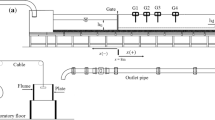Abstract
When studying the dam-break flow phenomenon, the basic hydrodynamic features of the dam-break flow at the gate location should be verified primarily. In this study, laboratory experiments were performed in a rectangular and horizontal flume with the same initial water head setting on the dry and wet downstream bed conditions. Water surface elevation was extracted through image analysis and validated by comparing with the data measured using a wave gauge. Temporal variation of the water surface elevation at the gate location, quantified in terms of high-speed video recorded images, can be divided into three stages, the sharp decreasing stage, the relatively steady stage, and the gradually decreasing stage. Applicability of several classic analytical solutions of the dam-break problem at the gate location was validated using present experimental data. Ritter’s solution is effective for the dry bed condition while Stoker’s solution could be applied to the wet bed case, and both are only applicable during the steady stage. Lin’ solution reproduces the gate-site hydrographs well during both the relatively steady and the gradually decreasing stages, especially for the condition under which the down-upstream water depth ratio is smaller than 0.138.
Similar content being viewed by others
References
Bukreev, V. I., and Gusev, A. V., 2005. Initial stage of the generation of dam-break waves. Doklady Physics, 50 (4): 200–203.
Chang, T. J., Kao, H. M., Chang, K. H., and Hsu, M. H., 2011. Numerical simulation of shallow-water dam break flows in open channels using smoothed particle hydrodynamics. Journal of Hydrology, 408 (1): 78–90.
Deng, X., Liu, H., Jiang, Z., and Baldock, T., 2016. Swash flow properties with bottom resistance based on the method of characteristics. Coastal Engineering, 114: 25–34.
Dressler, R. F., 1954. Comparison of theories and experiments for the hydraulic dam-break wave. International Association of Sciences Hydrology, 3 (38): 319–328.
Imamura, F., Goto, K., and Ohkubo, S., 2008. A numerical model for the transport of a boulder by tsunami. Journal of Geophysical Research Oceans, 113 (C1): 236–254.
Jánosi, I. M., Jan, D., Szabó, K. G., and Tél, T., 2004. Turbulent drag reduction in dam-break flows. Experiments in Fluids, 37 (2): 219–229.
Kocaman, S., and Ozmen-Cagatay, H., 2015. Investigation of dam-break induced shock waves impact on a vertical wall. Journal of Hydrology, 525: 1–12.
Lauber, G., and Hager, W. H., 1998. Experiments to dambreak wave: Horizontal channel. Journal of Hydraulic Research, 36 (3): 291–307.
Lin, B., Gong, Z., and Wang, L., 1980. Dam-site hydrographs due to sudden release. Scientia Sinica, 23 (12): 1570–1582.
Liu, H., and Liu, H., 2017. Experimental study on the dambreak hydrodynamic characteristics under different conditions. Journal of Disaster Research, 12 (1): 198–207.
Liu, H., Ying, B., and Liu, H., 2016. An experimental study of the influence of gate releasing time to the dam-break hydrodynamics. Proceedings of the Second Conference of Global Chinese Scholars on Hydrodynamics, Wuxi, 251–256.
Ozmen-Cagatay, H., and Kocaman, S., 2011. Dam-break flow in the presence of obstacle: Experiment and CFD simulation. Engineering Applications of Computational Fluid Mechanics, 5 (4): 541–552.
Ritter, A., 1892. Die fortpflanzung de wasserwellen. Zeitschrift Verein Deutscher Ingenieure, 36 (33): 947–954 (in German).
Shigematsu, T., Liu, P. L. F., and Oda, K., 2004. Numerical modeling of the initial stages of dam-break waves. Journal of Hydraulic Research, 42 (2): 183–195.
Stansby, P. K., Chegini, A., and Barnes, T. C. D., 1998. The initial stages of dam-break flow. Journal of Fluid Mechanics, 374: 407–424.
Stoker, J. J., 1957. Water Waves. Interscience Publishers Inc., New York, 333–341.
Acknowledgements
This study was financially supported by the Natural Science Foundation of Zhejiang Province, China (No. LR14E090002), the National Natural Science Foundation of China (No. 11632012), and the Open Research Fund Program of State key Laboratory of Hydroscience and Engineering (No. sklhse-2016-B-02).
Author information
Authors and Affiliations
Corresponding author
Rights and permissions
About this article
Cite this article
Liu, H., Liu, H., Guo, L. et al. Experimental study on the dam-break hydrographs at the gate location. J. Ocean Univ. China 16, 697–702 (2017). https://doi.org/10.1007/s11802-017-3470-x
Received:
Revised:
Accepted:
Published:
Issue Date:
DOI: https://doi.org/10.1007/s11802-017-3470-x




